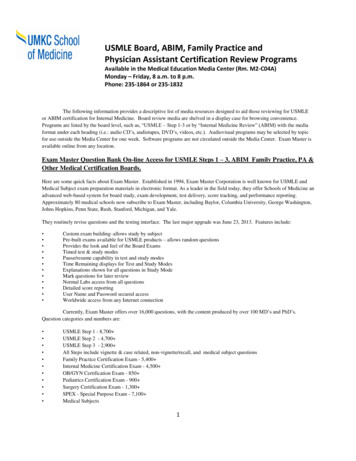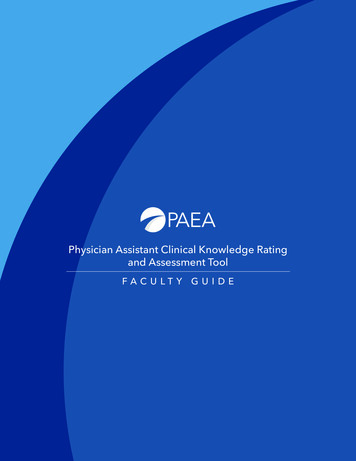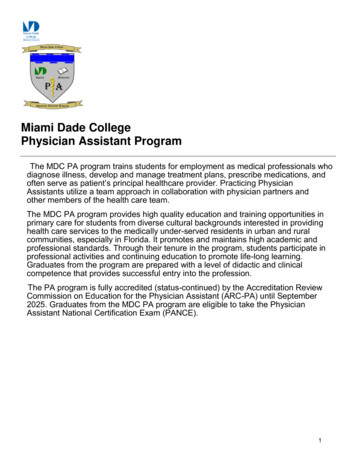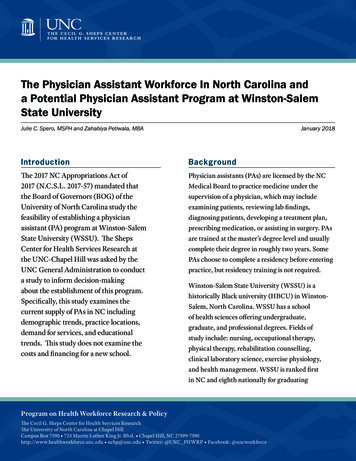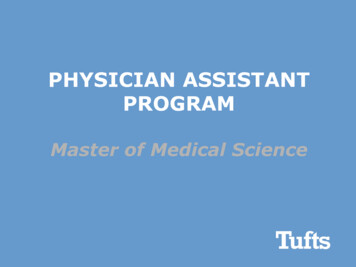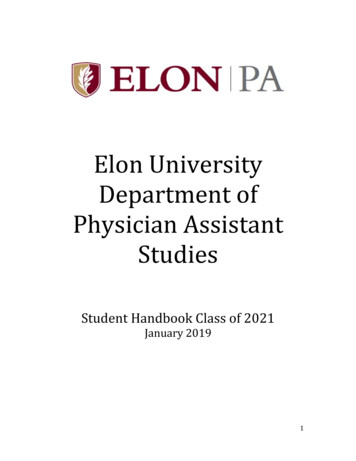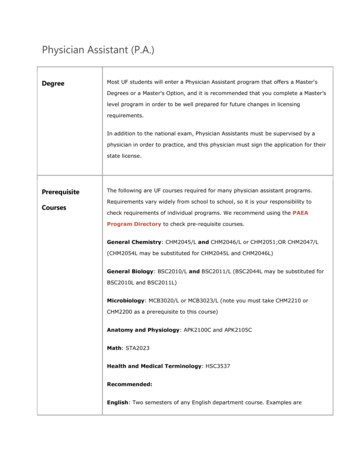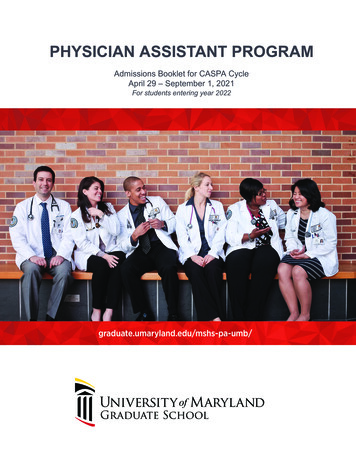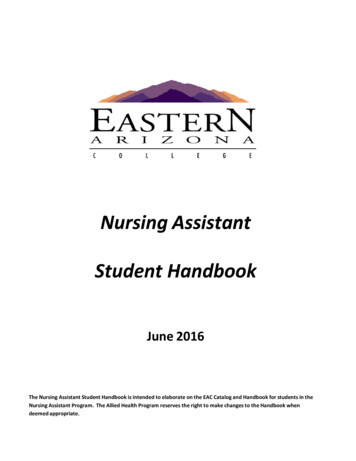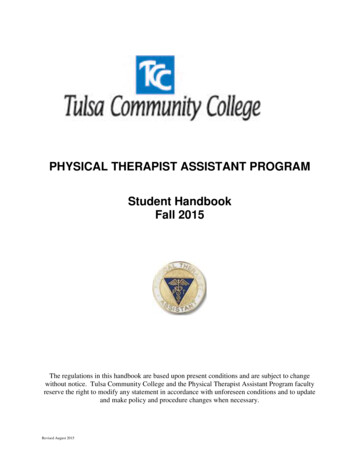
Transcription
PHYSICIAN ASSISTANTSTUDENT HANDBOOKClass of 2023Notice of Changes to HandbookThis handbook is as accurate and complete aspossible at the time of distribution and is subjectto revision/clarification by faculty at any timeduring student enrollment in the PA Program.Students will be notified of significant changesthat may affect the educational experience.CONTACT INFO:physician.assistant@wichita.edu(316) 978-3011Last Revised 05/2021Notice of NondiscriminationWSU does not discriminate in its programs andactivities based on race, religion, color, nationalorigin, gender, age, sexual orientation, maritalstatus, political affiliation, status as a veteran,genetic information, or disability. The Directorof the WSU Office of Equal Employment1Opportunity has been designated to handleinquiries regarding nondiscrimination policies:(316) 978-6791.
TABLE OF CONTENTSWSU PA Program Overview & HistoryHistory of the PA Profession . 4History of the WSU PA Program / Vision, Mission, & Guiding Principles . 5Faculty & Staff . 6Program Curriculum . 7Program Learning Outcomes / Curriculum / Evaluation Crosswalk . 8General Student Performance ExpectationsStudent Code of Conduct . 10Academic Honesty & Standards of Professional Conduct . 12Attendance Expectations. 13Student Dress Code . 14Guidelines for Use of Social Media. 15Advising & Counseling . 16WSU PA Student Society & Class Officers . 16Working during the Program . 16Enrollment, Tuition & Fees . 16Commencement . 16Formative & Summative Student EvaluationStandards of Academic & Professional Performance. 17Student Evaluation – Didactic Year . 17Student Evaluation – Clinical Year . 18Unsatisfactory Clinical Rotation Evaluation . 18Academic Probation (Warnings / Remediation). 19Professional Probation (Warnings / Counseling) . 20Student Responsibilities Regarding Formative Evaluation . 20Y1 & Y2 Summative Evaluations . 21Accommodation for Learning or Physical Disability . 22Admissions & Progressions Committee (APC) DecisionsRoles/Responsibilities of the Admissions & Progressions Committee . 23Voluntary Withdrawal . 24Voluntary Leave of Absence . 24Voluntary Deceleration . 24Delayed Graduation. 24Mandatory Deceleration . 25Dismissal . 25Program Appeal Policy . 25WSU Graduate School Grievance Procedure . 26PA Program Office PoliciesPA Department Office Policy . 27Faculty Office Hours . 27Faculty as Personal Medical Providers . 27Student Contact Information . 27Communication with Program & Faculty . 272
Campus & Student SafetyBuilding Access after Normal Hours . 28Emergency Alert System “Shocker Alert System” . 28Tornado Emergency Shelter . 28Fire Emergency or Drill . 28Earthquake Emergency Shelter . 29Active Shooter . 29Infectious, Occupational, & Environmental Hazards. 29Universal Precautions . 30Blood-borne Pathogen Exposure Procedure (Needle Stick or Blood Exposure) . 31Student Health & Related Rotation RequirementsStudent Health Information & Insurance . 32Physical Examination / Immunizations. 32Background Checks / Drug Screening. 32Student Health Services . 32Malpractice Insurance . 32Guidelines for the Didactic YearPhysical Exams & Clinical Skills . 33Blackboard (Bb) & Class Handouts . 33Testing Guidelines . 33Classroom Guidelines . 33Guidelines for the Clinical YearGoals of the Clinical Year . 34Self-Directed Learning during the Clinical Year . 34Required Clinical Rotation Experiences . 34Student Evaluation of Clinical Site / Rotation Preceptor . 36Incident Reports . 36Changing or Canceling Rotations. 36Rotation Planning – When, Where & What . 37Guidelines for Clinical Activity . 38Transportation . 39Patient Encounter & Procedure Tracking – EXXAT . 39Program Responsibilities to the Preceptors . 39Student Responsibilities to the Preceptors . 40Program Expectations of the Preceptors . 40Experiential Learning PassportProfessional Development / Service Learning / Research / Interprofessional Education . 41AppendicesAppendix A – Academic & Technical Standards . 42Appendix B – Descriptions of Professional PA Organizations . 43Appendix C – AAPA Code of Ethics . 44Appendix D – AAPA Ethical Conduct for the PA Profession . 45Appendix E – Exposure Report (Sharps Injury Log. 29 CFR 1904) . 51Appendix F – WSU Student Concern Resolution Guide . 523
WSU PA Program Overview & HistoryHistory of the PA ProfessionIn 1965, Dr. Eugene Stead of Duke University founded the first PA training program. Soon after, similarprograms were started in other states, and by 1971 over 50 PA programs had been established in colleges,universities, and medical centers across the country. Existing financial support from the government wasexpanded in 1971 with passage of the Comprehensive Health Manpower Act and continued into the 1980s inthe form of categorical grants funded under the authority of the Health Professions Educational Assistance Act.The medical establishment joined in early efforts to solidify the PA profession. In 1970, the American MedicalAssociation (AMA) House of Delegates encouraged states to amend medical practice acts to allow physicians todelegate tasks to qualified PAs. The following year, the AMA took steps, through its Council on MedicalEducation, to recognize and accredit the rapidly growing number of PA training programs.The founders of the PA concept believed that the key to success was a close relationship with physicians.Therefore, efforts to legally sanction PA practice were aimed at modifying existing laws to allow physicians todelegate a wide variety of medical tasks to PAs. PAs performed duties previously performed only byphysicians—obtain medical histories, perform physical examinations and procedures, order treatments, providepreventive and health maintenance services, diagnose diseases, prescribe medication, order and interpretdiagnostic tests, refer patients to specialists as required, and assist in surgery.A physician-collaborative role affords PAs a large amount of responsibility and autonomy without usurping theultimate authority of physicians. Thus, the legal basis for PA practice is built upon physician collaboration, arelatively unique arrangement among health care providers. For more information, refer to the AmericanAcademy of Physician Assistant (AAPA – www.aapa.org) Policy Manual, (policies HP-3100.2.0 & HP-3100.3.0).To ensure the competence of PAs entering medical practice, the AMA and the PA profession worked with theNational Board of Medical Examiners to develop a national competency examination. In 1975, the NationalCommission on Certification of Physician Assistants (NCCPA), in conjunction with the National Board of MedicalExaminers, was created to administer an entry-level examination as well as periodic recertification exams.The AAPA, established in 1968, serves the interests of graduate and student PAs in areas such as governmentaffairs, public education, and professional development, while its chapters work to advance the profession onthe state level. A closely related organization, the Physician Assistant Education Association (PAEA), representsthe interests of PA educational programs (Appendix B).Currently, over 120,000 PAs work in a variety of primary care and specialty practices. PAs practice medicine in all50 states as well as internationally and are authorized to prescribe medications throughout the 50 states, in theDistrict of Columbia, and in the Territory of Guam. The number of PA programs has grown from just over 50programs in the early 1970s to the over 240 programs which exist today. PAs are recognized as one of threeprimary health care providers in the Affordable Care Act.Most states have academies that advocate for PA-positive laws and regulations to allow for the highest level ofpatient care within the state. In Kansas, the Kansas Academy of Physician Assistants (KAPA) serves in this role.For more information regarding professional PA organizations (Appendix B).4
History of the WSU PA ProgramThe WSU PA Program opened in the fall of 1972 and started its first class of 12 students in January 1973. Atthat time, the Program was housed at the VA Medical Center. In 1980, the Program moved to Ahlberg Hall onthe WSU campus. In 2017, the Program moved to the WSU Old Town Campus. The WSU PA Program is theonly PA program in Kansas and is one of the older and larger programs in the U.S.Prior to 1989, PA graduates received a Certificate of Completion or a Bachelor of Health Science (BHS) if theymet University requirements for the degree. Starting in 1989, all graduates received a Bachelor of Science –Physician Assistant. Following adoption of a graduate degree, students entering the Program beginning in 2004began receiving a Master of Physician Assistant (MPA) degree following successful completion of the Program.The Program has graduated over 1,700 PAs.In 1995, the Kansas Health Foundation provided a 1.3 million-dollar grant to increase the size of the Program by50%, with the primary goal of increasing the number of PAs practicing in underserved rural Kansas communities.Admissions to the Program increased from 60 to 90 students over a two-year period. The grant included fundsto renovate and enlarge the classroom, provide multimedia instructional capability, add two faculty positions,and increase the Program’s infrastructure in the area of instructional resources. Also included in the grant werefunds for faculty salary enhancement, which were intended to strengthen faculty recruitment and retention.The PA Program has been fully accredited by the Accreditation Review Commission on Education for PhysicianAssistants (ARC-PA) since its inception.The WSU PA Program is a member of the Physician Assistant Education Association (PAEA). In addition, it has along history of support for and cooperation with the Kansas Academy of Physician Assistants (KAPA).Our Vision, Mission & Guiding PrinciplesVision: Excellence in physician assistant educationMission: Transform students into highly competent physician assistantsGuiding principles: Foster an enthusiastic learning environment committed to student success Promote patient-centered collaborative care Model and cultivate compassion Respond to the need for primary care providers in Kansas Encourage health care for rural and underserved populations Emphasize evidence-based practice and promote lifelong learningIt is the intent of the Program that the education and training received within the Master of Physician Assistant(MPA) degree will prepare and encourage students to provide primary care in areas where the need is greatest.Service and clinical education in underserved and rural areas and with minority populations is emphasized.Therefore, students will have exposure to rural and underserved health care sites as part of their clinicalrotations.5
Faculty & StaffProgram Director:Gina Brown, MPAS, PA-CAssociate Professor; Director of Didactic EducationDepartment Chair:LaDonna Hale, PharmDProfessor; Director of AssessmentFaculty:Chris Dudley, MPAS, PA-CAssistant Clinical ProfessorRonda Hanneman, MPH, PA-CAssistant Clinical Professor; Director of Clinical EducationEvan Ohlman, MPAS, PA-CAssistant Clinical ProfessorLori Ridder, MPAS, PA-CAssistant Clinical ProfessorCorey Rogers, MPAS, PA-CAssistant Clinical Professor; Director of Technology IntegrationMichelle Wallace, MPAS, PA-CAssociate Clinical Professor; Director of Research & Applied LearningMedical Director:Garold Minns, MDBasic Science Faculty:Garold Minns, MD (Pathophysiology)Lisa Garcia, MS (Anatomy), Associate Clinical ProfessorSupport Staff:Melanie BaylesClinical CoordinatorTerri CorneliusDirector of AdmissionsDebbie FlaxAdministrative SpecialistJeff QuinnAdministrative AssistantDepartment ContactInformation:1845 N. Fairmount StreetWichita, KS 67260-0214Phone: 316-978-3011Fax: 316-978-3669physician.assistant@wichita.eduOffice Hours:Monday-Friday: 8 a.m.-12 p.m. and 1 p.m.-5 p.m.Voicemail is available 24 hours a day.6
Program Curriculum93 Graduate Credit HoursFirst Year / Academic Year (approximately 1
The WSU PA Program is the only PA program in Kansas and is one of the older and larger programs in the U.S. Prior to 1989, PA graduates received a Certificate of Completion or a Bachelor of Health Science (BHS) if they met University requirements for the degree. Starting in 1989, all graduates received a Ba
